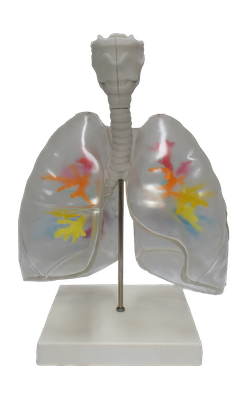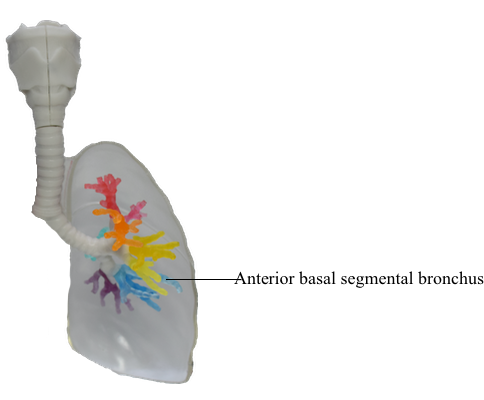Main Model

Right inferior lobar bronchus (bronchus lobaris inferior dexter) : B VIII anterior basal segmental bronchus

Beginning at the larynx, the walls of the airway are supported by horseshoe- or C-shaped rings of hyaline cartilage. The sub-laryngeal airway constitutes the tracheobronchial tree. The trachea, located within the superior mediastinum, constitutes the trunk of the tree. It bifurcates at the level of the transverse thoracic plane (or sternal angle) into main bronchi, one to each lung, passing inferolaterally to enter the lungs at the hila (singular = hilum).
• The right main bronchus is wider, shorter, and runs more vertically than the left main bronchus as it passes directly to the hilum of the lung.
• The left main bronchus passes inferolaterally, inferior to the arch of the aorta and anterior to the esophagus and thoracic aorta, to reach the hilum of the lung.
Within the lungs, the bronchi branch in a constant fashion to form the branches of the tracheobronchial tree. Note that the branches of the tracheobronchial tree are components of the root of each lung (consisting of branches of the pulmonary artery and veins as well as the bronchi).
Each main (primary) bronchus divides into secondary lobar bronchi, two on the left and three on the right, each of which supplies a lobe of the lung. Each lobar bronchus divides into several tertiary segmental bronchi that supply the bronchopulmonary segments.
The bronchopulmonary segments are:
• The largest subdivisions of a lobe.
• Pyramidal-shaped segments of the lung, with their apices facing the lung root and their bases at the pleural surface.
• Separated from adjacent segments by connective tissue septa.
• Supplied independently by a segmental bronchus and a tertiary branch of the pulmonary artery.
• Named according to the segmental bronchi supplying them.
• Drained by intersegmental parts of the pulmonary veins that lie in the connective tissue between and drain adjacent segments.
• Usually 18-20 in number (10 in the right lung; 8-10 in the left lung, depending on the combining of segments).
• Surgically resectable.
Beyond the tertiary segmental bronchi, there are 20 to 25 generations of branching conducting bronchioles that eventually end as terminal bronchioles, the smallest conducting bronchioles. Bronchioles lack cartilage in their walls. Conducting bronchioles transport air but lack glands or alveoli. Each terminal bronchiole gives rise to several generations of respiratory bronchioles, characterized by scattered, thin-walled outpocketings (alveoli) that extend from their lumens. The pulmonary alveolus is the basic structural unit of gas exchange in the lung. Due to the presence of the alveoli, the respiratory bronchioles are involved both in air transportation and gas exchange. Each respiratory bronchiole gives rise to 2-11 alveolar ducts, each of which gives rise to 5-6 alveolar sacs. Alveolar ducts are elongated airways densely lined with alveoli, leading to common spaces, the alveolar sacs, into which clusters of alveoli open. New alveoli continue to develop until about age 8 years, by which time there are approximately 300 million alveoli.